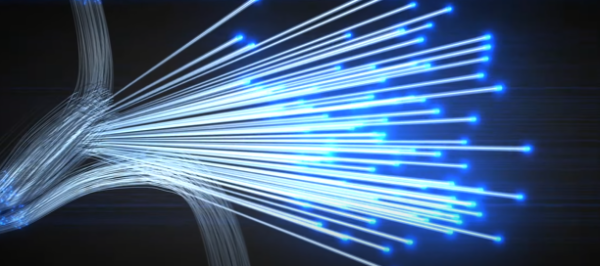What Is Optic Fiber HDMI Cable?
November 06, 2022 4 min read
The word fiber optic HDMI cable is wrongly hyped. The word itself is fascinating. Isn't it?But you won't see it at home? It's a minor start of a revolution in the entertainment industry.
So, Fiber Optic HDMI cable is the fastest medium to transfer data using light pulses. It is best suitable to send an A/V signal to far away distances.
Here is every possible reason why you should love and hate it. Let's first determine whether you need a beasty fiber optic HDMI cable or NOT.
Do Fiber Optic HDMI cables need power?
Fiber Optic cable needs a 5V power source. Almost all HDMI ports fuel energy into the optical system of fiber optics. Does that mean you can increase the length without worrying about the power source?
There are some instances that you may need a voltage inserter for a constant 5v power supply. For example, if your HDMI input and output connections extend over 60 ft (25 feet if you're using copper HDMI cable), there is a possibility of voltage drain. In this situation, you should use a Voltage Inserter between HDMI Source and Sink to stimulate power, so it transfers data smoothly.
Do I need an optical HDMI cable?
Regarding the internet connection, a fiber optic connection is a blessing. With higher bandwidth, fiber optics internet has encouraged us to send images and videos to friends and family. Having a reliable and healthier internet, you now stay attached to the world. It's horrifying to imagine life with slow browsing and choppy streaming. In short, you can't imagine living a single day without fast internet.
That said, you must know fiber optic HDMI cables are not as popular as internet-carrying fiber optical connections. This revolutionary tech has yet to create space for survival.
Because when it comes to delivering 4k, both copper and fiber optic HDMI cables produce similar video quality.

The only advantage fiber optic HDMI may have compared to conventional HDMI cable is the 8k content delivery over longer distances. However, what about the ability of devices to process heavy 8k video? Even if all your devices (laptops, Tv, Phones, Tablets) are 8k compatible, you may not enjoy high pixelated videosas 8k content is scarce. If your device isn't supporting 8k, no matter what cable you use, you won't reap any fruit.
Undoubtedly, fiber optic HDMI cables can transfer data over longer distances (1000ft) without interruption or data loss.
But, do you need this much distance?
Surely not.
For domestic use, a simple HDMI repeater will allow you to achieve a flawless signal flow at a considerable distance, depending on whether you've got a high-quality HDMI cable.
With a nicely built branded HDMI cable, you'll have all power to send a 4k video signal up to 30 ft. Beyond this length, the chances of signal damage increase, resulting in video blackout.
Fiber Optic HDMI Cable Problems
- The most significant disadvantage of fiber optic HDMI cable is that it's not bidirectional. Fiber HDMI has a designated input and output. You can't randomly insert any of its edges into the port. Thus, you must differentiate input and output connectors first, then connect them with the right devices or display monitor ports.
- Since fiber optic HDMI cable sends signals in one direction, you'll lose HDMI ARC or EARC
- More importantly, you'll have to empty your pockets purchasing these cables as they are 3X more expensive than an ordinary HDMI cable. Instead, you have a much better alternative: Wireless HDMI
- Lastly, as noted earlier, these cables can throw data to longer distances, yet only a 60ft cable is still floating on the market.
Fiber Optic HDMI Cable Vs. Copper HDMI Cable: Which One Is Better?
If we compare fiber optic technology with copper wires, the latter is losing. While copper-built HDMI carries data using an electromagnetic field, the fiber optic HDMI cable uses a sharp beam of light.
More importantly, copper-built HDMI welcomes other electric interferences, killing signal. In contrast, fiber optic HDMI cables deliver a much more stable signal because they never face any trouble from the nearby electric field.
Yet, regarding durability, fiber optic HDMI can be problematic sometimes. Normally durable, fiber optic HDMI cables can get damaged with hard twisting and little stretch resulting in a complete blackout.
Finally, Is Fiber Optics HDMI The Best Choice? What does Uni think?
They will be, indeed. But not for NOW.
After all, the HDMI's ability to send audio/video signals simultaneously recognized it as a universal port. Later, enhancements in tech (ARC and eARC ) made it more famous. People love it as it eliminates the cluster of cables that they need for internet, audio, and video. On the contrary, as of today, Fiber Optic HDMI cable has no ARC/ EARC, making it the best fit for commercial needs only. These drawbacks of Fiber Optic HDMI cables fade away their urgent necessity.
Related Stories:
Leave a comment
Comments will be approved before showing up.
Also in Blog
How to Distinguish Low-Quality Electronic Waste on E-Commerce Platforms in 2025
March 19, 2025 3 min read
With the rise of online shopping, distinguishing between high-quality electronics and low-quality e-waste has become a critical skill. Many e-commerce platforms are flooded with questionable products that look appealing but often have serious quality and longevity issues.

Maximizing Your Internet Speed: The Ultimate Guide to Using a USB-C to Ethernet Adapter
July 12, 2024 4 min read
Read More Related Stories
· What Is Optic Fiber HDMI Cable?
//
1. [Solved] USB C to HDMI Adapter Cable Not Working in 2022
2. Best Product for Remote Work and Entertainment
3. How to Set Up Dual Monitors for Laptop
4. How to use USB-C to HDMI Cable
5. How to spend time at home during the Covid-19 pandemic?
6. How to choose a suitable USB hub at a good price?
7. How does a 2.5G Ethernet Adapter work with my laptop?
SUPPORT


